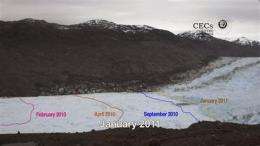Rapid retreat of Chile glacier captured in images

(AP) -- Researchers in Chile released a series of time-lapse photos Wednesday showing the dramatic retreat of a glacier in Patagonia.
The Jorge Montt Glacier is shrinking faster than any other in Chile, with its snout retreating 1 kilometer (more than a half mile) between February 2010 and January 2011, glaciologist Andres Rivera said.
Rivera said that global warming is a factor and that the glacier also is melting especially quickly because it partly rests in the waters of a deep fjord.
Researchers presented a video showing the glacier's yearlong retreat through a total of 1,445 time-lapse photos. It's one of various similar projects by researchers around the world documenting the loss of glaciers.
Rivera has studied dozens of glaciers as a researcher at the Center of Scientific Studies in Valdivia, Chile. He said he and his colleagues didn't know how rapidly the glacier was shrinking until they put up two cameras with solar panels to charge the batteries and programmed them to shoot four frames a day.
"It was more or less clear that this was one of those retreating most quickly. But we didn't expect in the year of working with these cameras that it would retreat a kilometer more. That was a surprise," Rivera said in a telephone interview. "This glacier is filled with surprises for us."
The glacier is about 1,800 kilometers (1,100 miles) south of Santiago in the Southern Patagonian Ice Field, which blankets a wide swath of the Andes between Chile and Argentina.
"Patagonia has experienced climate changes at levels much more moderate than those observed in the rest of the world," Rivera said at a news conference. "However, almost all the glaciers of the region have lost area, and Jorge Montt is the one that has the record retreat."
The researchers believe that based on a map from 1898, this glacier has retreated roughly 12 miles (19.5 kilometers) since then, Rivera said.
It is a tidewater glacier that calves and releases icebergs as it advances into the fjord.
"Such glaciers typically do retreat in response to warming. But the speed of the retreat is controlled by the ability of icebergs to break off in the fjord, not by the rate of warming," said Richard Alley, a prominent glaciologist at Penn State University.
Rivera agreed, saying that he thinks climate change is the key trigger and that local conditions at the glacier are also having a big impact. He said his team measured the fjord's depth at about 1,300 feet (400 meters) in places, which was considerably deeper than they had thought.
The retreat rate of the glacier "is quite exceptional," said Michel Barer, a researcher at McGill University in Montreal who has studied the melting of Peruvian glaciers.
Barer and other glacier experts at a conference of geophysical scientists in San Francisco said the fastest retreating mountain glaciers are probably somewhere in South America or maybe the Himalayas.
"We see steady but accelerating retreat of glaciers" in the tropical Andes, Barer said. His calculations show that those glaciers are losing 1 percent of their water a year.
According to a recent study by British and Swedish scientists who analyzed about 350 glaciers in Patagonia, all but two of the glaciers have receded significantly since the late 1800s and have been shrinking at a faster rate during the past three decades. The study was published in April in the journal Nature Geoscience.
Neil Glasser, a British glaciologist and one of the authors of the study, said he has also noticed in satellite images over the years that the Jorge Montt Glacier has been shrinking unusually quickly.
"We know that many glaciers in South America are retreating, but this one is retreating ten times faster than the land-based glaciers. It shows how sensitive calving glaciers are to warming atmospheric (conditions) and ocean waters," Glasser said.
He said other tidewater glaciers have quickly retreated in places such as Alaska and Greenland, but the Chilean glacier is one of the best examples in South America.
Patagonia's mountain glaciers are so colossal, and fed by so much snowfall each winter, that scientists believe they aren't in immediate danger of vanishing in the coming centuries.
But elsewhere, scientists expect glaciers to dwindle. Western Canada, for instance, is losing its mountain glaciers and many of them are likely to disappear in the next century, said Garry Clarke, a professor of Earth Sciences at the University of British Columbia.
©2011 The Associated Press. All rights reserved. This material may not be published, broadcast, rewritten or redistributed.



















